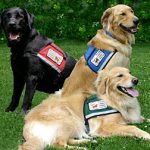Do you have a Service Animal Policy?
SERVICE ANIMALS
by: Michelle Pineda, OMIC Risk Manager
Do you have a Service Animal Policy?**
Do you know the two questions you are allowed to ask about the service animal?
Do you know what the ADA requirements are regarding posting a sign in your office stating, “Service Animals Welcome”?
Facts:
A patient showed up for a scheduled medical appointment at an OMIC insured retina practice with a dog. The patient did not call ahead to let the practice know that he was bringing a service animal with him to the appointment. When the doctor told the patient that the animal was not allowed into the sterile treatment room, words were exchanged, and the patient left the office prior to the exam. The patient filed a claim with the U.S. Department of Justice and the State Medical Board alleging discrimination and a violation of the ADA requirements regarding service animals.
The medical office was required by the U.S. Department of Justice to draft and submit for approval their service animal policy. They were also required to post a sign informing patients that SERVICE ANIMALS ARE WELCOME. The sign had to be in a font of (26) or larger, on a contrasting white background.
The insured was required to pay the patient a $1000 fine.
**The two questions you are allowed to ask about the service animal are:
- Is this animal required because of a disability?
- What tasks has the animal been trained to perform?
Resources:
ADA Requirements Overview (including miniature horse discussion): Overview and Miniature Horse Addendum
FAQ about Service Animals and the ADA: ADA Regulations
Understanding How to Accommodate Service Animals in Healthcare Facilities: HHS Document
OMIC Sample Policy: Policy
OMIC Example of Sign for Office (must be certain text size and on white background): Service Animal Flyer and Court Document Service Animals
** Emotional Support Animals (ESA’s) do not have the same rights/access as Service Animals.
Where can ESA’s go?
Fair Housing Act: ESA is a reasonable accommodation for a person with a disability.
Air Carrier Access Act: Disabled person with a letter from a mental health professional verifying the emotional benefit of the animal will be allowed to travel with the animal.
Check Local Ordinances: In San Francisco, ESA is allowed equal access to all City sponsored programs, facilities, services, and activities.
Last Revision November, 2018
Raindrop Near Vision Inlay Recalled
UPDATE: Device recalled 3/5/19
The FDA issued a Safety Alert about the Raindrop Near Vision Inlay on October 23, 2018. On March 5, 2019, the FDA recalled the device and updated the Safety Alert (https://www.fda.gov/MedicalDevices/Safety/AlertsandNotices/ucm623973.htm), which states:
“People who undergo implantation of the Raindrop Near Vision Inlay device are at risk for the development of corneal haze that can affect clear vision. Haze can cause blurry vision or glare by clouding the cornea, or by changing the focusing power of the eye. The impact of haze on the patient’s vision is dependent on the severity of haze and its location in the cornea.”
The FDA made the following recommendations:
- Do not implant Raindrop inlays.
- Contact Optics Medical (Phone: 949-330-6511) for instructions on returning any unused product to the firm.
- Be aware of the new data from the ongoing post-approval study, which is showing 1) high rates of corneal haze in both implanted and explanted patients, 2) an increasing rate of device removal, and 3) that some cases of haze did not develop until 60 months post-implant.
- Monitor patients with the implant, and those whose device has been explanted, for the development of corneal haze.
Risk management recommendations (click “download” for the letter)
OMIC recommends that you take the following steps to promote patient safety and reduce your liability exposure:
PATIENTS ALREADY NOTIFIED OF THE SAFETY ALERT AND EVALUATED
- Update patients when they present for their next appointment.
- Share your current findings, and explain your plan for monitoring the eye.
- Educate them about symptoms that should be reported to you.
- Document the discussion.
PATIENTS WHO WERE NOT NOTIFIED OR NOT EVALUATED
- Send a Letter to patients about recall of Raindrop corneal inlay via regular mail, and ask them to call your office to make an appointment.
- Place a copy of the letter in the patient’s medical record, and send a copy to the referring ophthalmologist or optometrist.
- When you do examine the patient, determine if there are any signs of corneal haze or other problems.
- Share your findings with the patient, and explain your plan for monitoring the eye.
- Document the findings and discussion.
OMIC policyholders may obtain confidential advice by contacting our Risk Management Hotline at 800-562-6642, option 4, or riskmanagement@omic.com.







